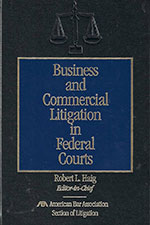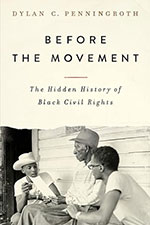 VERDICT: Touchdown!
VERDICT: Touchdown!
Business and Commercial Litigation in Federal Courts, Fifth Edition
By Robert L. Haig editor-in-chief & 296 authors (New York, NY: Thomson Reuters & ABA Litigation Section, 2022). 18 vols., 23,000 pgs. $2,088.
Reviewed by Nick Zales
Rapid changes in technology lead to significant changes in the practice of law and the business of our clients. The fifth edition in hardcopy form is an 18-volume treatise. It contains 23,000 pages, 180 chapters (26 of them on new topics), and over 50,000 case citations.
The online version has hyperlinks to every case and statute cited, as well as links to scholarly works and resources cited by the authors.
The authors include some of America’s best-known practicing lawyers and judges, including Wisconsin’s own federal judge, the Hon. Lynn Adelman (chapter 22: Claim and Issue Preclusion).
New chapters include such hot topics as artificial intelligence, budgeting for litigation, climate change, comparing state and federal litigation, fee arrangements, litigation management by judges, third-party litigation funding, use of jury consultants, valuation of a business, and virtual currencies.
The ultimate test of any legal treatise is whether it is worth the cost and whether it makes me a better lawyer. For this book, the answer to both questions is yes. It is easy to navigate, contains a comprehensive analysis of every aspect of commercial litigation, and offers practical, well-organized advice. No lawyer will read it from cover to cover. They will use the chapter relevant to the aspect of litigation they find themselves in. Whether about pleadings, discovery, motion practice, trial evidence, jury selection, post-verdict motions, or simply analyzing what to do in a particular situation, this treatise offers valuable guidance.
I have used this treatise often to help in litigation in state and federal court. Wisconsin and federal civil procedure are similar enough that advice as to federal litigation applies to state court litigation. The treatise offers ideas and concepts that as a sole practitioner I would not have thought of. It has helped me organize a litigation plan and offered me comprehensive advice for discovery and motion practice issues. This treatise provides advice that allows a sole practitioner to punch above their weight and successfully deal with litigation against larger law firms. It is a valuable resource for any law firm. But it provides small law firms with advice and guidance from the best, something that they could not figure out on their own. Experience teaches and this book is a great teacher.
At $2,088, the cost is significant. There is an online version and one in hard-bound books. I prefer the books, but they do take up space and the set is heavy. The online ProView version has the advantage of being available to you wherever you go. That is a huge advantage. It is a matter of personal preference. The cost is significant, but you will make it up with just one significant case in state or federal court. The volumes of material, analyses, case citations, and strategic considerations provided are something almost impossible for a solo or small-firm lawyer to obtain on their own. This treatise will make you a better lawyer and a better representative of your clients. In terms of what it provides, the cost is not as great as it seems.
One option for solos and small firms would be to purchase a subset of the treatise. Volumes 1 and 3-7 (volume 2 is New York-law specific) for $750 would be an incredible bargain. These cover the essentials of civil procedure from pleadings through appeal. This is $1 million worth of legal advice and guidance for a bargain price. A real winner.
Nick Zales, Marquette 1989, is a Milwaukee sole practitioner and a member of the State Bar of Wisconsin’s Board of Governors.
 VERDICT: It’s a Keeper
VERDICT: It’s a Keeper
Before the Movement: The Hidden History of Black Civil Rights
By Dylan C. Penningroth (New York, NY: Liveright Publishing Corp., 2023). 496 pgs. $35. Order, www.amazon.com.
Reviewed by Dianne Post
The book was very different from what I had expected. I knew that Africans had never accepted their enslavement and had fought back from the outset. I expected detail about that fight in terms of uprisings, escapes, plots, and so on. The book was instead about how they fought back but in a very different way – enshrining their rights as citizens in the law.
After the end of the Civil War, the newly freed people engaged robustly with the legal system primarily on issues of property and contract but also on family law and inheritance. “Civil rights” at that time was defined as being able to own property and being able to engage in contractual matters – both situations denied to them previously. Blacks went about enforcing those rights vigorously. Because whites sold land and other property to them and had to contract with them, it was to the advantage of whites to act as if Blacks had the same legal agency. That did not extend to what were considered “social” rights, that is, living, working, or even being together on public transportation or any other “assembly” right.
Want to Review a Book?
Please request a book and writing guidelines from the Wisconsin Lawyer managing editor at wislawmag@wisbar.org. Reviewers may keep the book reviewed. Reviews of about 500 words are due within 45 days of receiving the book. Reviews are published, space permitting, in the order received and may be edited for length and clarity.
Penningroth outlines the evolving definition of civil rights and the relationship of Blacks with U.S. laws. The author researched 14,000 county records to find his cases, some of which told very interesting stories about the status of laws at the time and how litigants were treated in court. I found some of his interpretations and extrapolations a reach. It took a while to get into the book and I found that once I understood the main point, it was more engaging.
The ”civil rights” movement in the 1800s was about obtaining property and contract rights, not integration with whites. The kind of “law” that most people are in contact with was called ordinary rights of freedman or rights of everyday use. Using the law shows the respect society owes you as a person.
In the 1960s “civil rights” movement, issues of social rights and discrimination became the focus and overtook the issues of property and contract that then became “private.” Legal education does not reflect this important history even though in some cases brought by Blacks, the outcomes had lasting effects on laws, for example, what is unconscionable and rights a tenant has versus the landlord.
The book ends with two issues that resound today – the ethics and responsibility of “movement lawyering” and whether law is or should be color-blind. This is a very interesting and important book for those who want to know about the evolution of law and race relations.
Dianne Post, U.W. 1979, is an international human rights lawyer. She practiced family law in Arizona for 18 years, mostly representing battered women and molested children, and then in 1998 began doing international work mainly on gender-based violence.
» Cite this article: 97 Wis. Law. 50-51 (March 2024).
